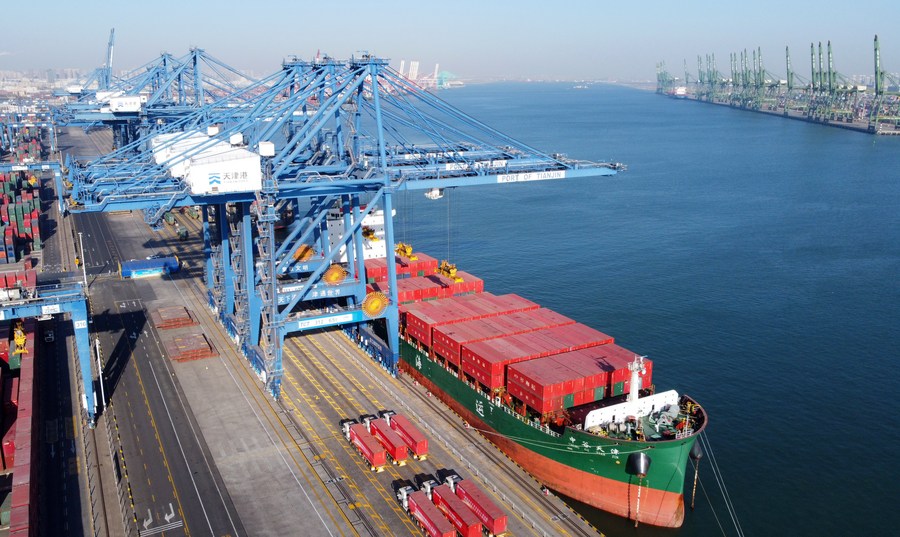Chinese ports get smart, build favorable environment
A ship loaded with 398 empty containers recently arrived at Tianjin Port in north China’s Tianjin Municipality. After going through an efficient customs clearance process conducted by the port using technologies such as a visualized inspection platform, the containers were quickly transported to foreign trade enterprises that needed them.
Tianjin Port has made major headway in smart port construction this year. It has put into use an upgraded version of the automated container handling system, which has an accuracy rate of at least 95 percent for the entire container handling process.

Aerial photo taken on Jan. 17, 2021 shows a smart container terminal at Tianjin Port in north China's Tianjin Municipality. (Xinhua/Zhao Zishuo)
According to Tianjin Customs, it now takes about 1.5 hours for enterprises to claim their containers compared with one to two days previously, and less than one hour for them to go through the customs clearance process compared with more than 8 hours in January 2019.
Tianjin Port is also the location of the world’s first autonomous driving demonstration zone. At this zone, driverless vehicles are guided by the Beidou navigation system to designated destinations and the containers are hoisted by remotely controlled cranes. No manual labor is involved in the process.
This year, customs departments have made great efforts in bringing about electronization of the customs clearance process. Statistics indicated that the number of certificates that foreign trade enterprises have to submit to customs departments for verification has been reduced to 41 from 86 in 2017, and 38 of those 41 certifications can be handled online.
“Major coastal ports have basically realized electronization of such certificates as equipment interchange receipts, container load plans and import bills of lading,” according to Dang Yingjie, deputy director-general of the National Office of Port Administration at the General Administration of Customs (GAC), who added that progress has also been made in promoting electronization of the Certificate of Inspection and Quarantine for Entry Goods to strengthen international data exchange and sharing.
In May, the national average export and import customs clearance time was reduced by 60 percent, which means that the work to improve clearance efficiency has proceeded smoothly and seen marked progress.
Customs departments now allow enterprises to declare their goods in advance and in just two steps, which has significantly improved clearance efficiency. For instance, by declaring goods to be imported in advance, a plastics foreign trade company based in east China’s Zhejiang province has reduced the time needed to go through the procedures by 14 hours, and claimed the goods upon their arrival at the port in just 26 minutes.
According to the GAC, in May, the average import clearance time was 38.93 hours, and the average export clearance time was 2.12 hours, down 60.03 percent and 82.74 percent, respectively, from that registered in 2017.
Photos
Related Stories
- China builds world-class smart, green ports
- Xinjiang border port sees rising rail freight volume
- China's busiest port sees record throughput
- China releases guideline to build world-class ports
- U.S. second busiest port expects to enhance trade links with China
- Freight train service connects Chinese port with Belgium
- Construction of Chinese-led port kicks off, aims to boost logistics capacity in NE Brazil
- Coastal Tianjin to apply for free trade port
- 13,200 tons of ‘imported waste’ returned by Ningbo port in 2017
- Chinese dredger to go global, aiming for broader application
Copyright © 2021 People's Daily Online. All Rights Reserved.










